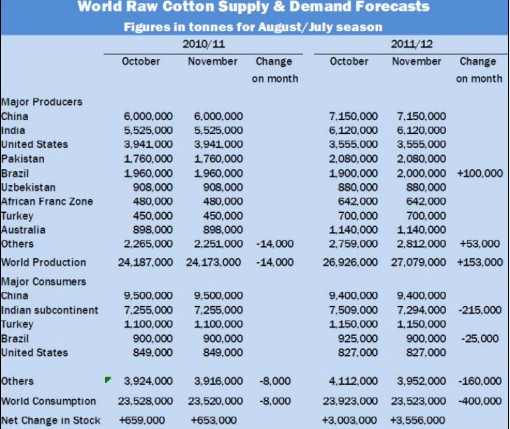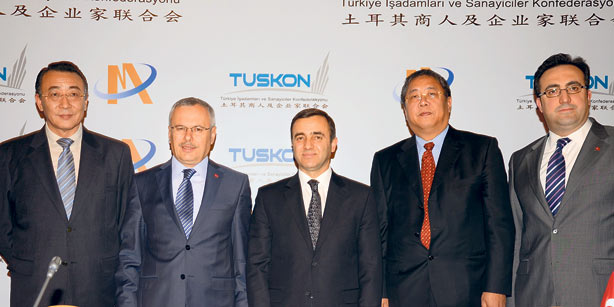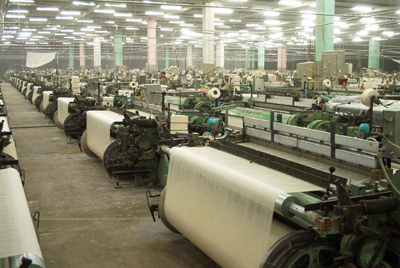|
ISLAMABAD: Pakistan¡¯s textile and clothing exports witnessed a decline of 14 per cent in October this year over the same month last year, sending fears to policy-makers that shrinking export proceeds in the sector may result in layoffs. No official word came from the ministry of industries over this sudden fall in export proceeds, which had recorded an impressive growth last year because of rising cotton prices in the international market. Pakistan¡¯s exporters are capable of marketing around $1.021 billion worth of textile and clothing products in October to international market against $1.181 billion last year, reflecting a decline of 13.51 per cent, suggests data of Federal Bureau of Statistics here on Monday. A sector-wise analysis shows negative growth in export of raw cotton, cotton yarn, cotton cloth and cotton carded and value-added finished products, like garments, knitwear, bed wear and towels. The only area, where some impressive growth was recorded was in export of yarn other than cotton yarn and tents during the month under review over last year. However, over-all growth in textile and clothing in the past four months posted 3.29 per cent growth, as it reached $4.207 billion in July-Oct this year from $4.073 billion over the corresponding period last year. But if no remedial measures were taken, over-all exports would enter a negative growth in the months ahead, which could cause balance of payment problem for the country. At the start of this year, former chairman of All-Pakistan Textile Mills Association Gohar Ijaz had claimed that the textile and clothing exports could touch the figure of $20 billion by end June 2012. But he conditioned it with energy supply and reduction in interest rates. This projection came on the back of last year¡¯s impressive growth in textile and clothing sectors, which reached around $15 billion by the end of June 2011. This growth, however, was mainly driven by the rise in cotton prices in the international market. At the same time, there was a significant decline in import of machinery in the value-added sector to increase quality and capacity of production. Statistics shows that textile machinery imports declined by 34 per cent in October and 23 percent in July-October this year over the last year, reflecting that the industrialists have no plan for expansion of their industrial units in the current year.Contrary to growth in textile and clothing, export of traditional products or non-textile products increased by 25 per cent to $3.65 billion during the July-Oct period of the current fiscal year as against $2.92 billion in the corresponding period last year. Nasir Jamal adds from Lahore: The quantitative decline in Pakistan¡¯s textile exports in the first four months of the current fiscal year to October from a year earlier is proportionate to the increase in the curtailment of gas supply to the industry in Punjab during the same period. ¡°The quantity of the textiles exported during July-October showed a drop of 12 per cent. It is proportionate to 14 per cent increase in gas curtailment for the industry,¡± says Gohar Ejaz, a business leader, while talking to Dawn on Monday. Growing gas shortages in Punjab have resulted in three days a week suspension in supply of the cheap fuel to textile industry during the first four months of this fiscal year from two days a week during the same period last year. Overall the industry has experienced gas supply suspension for 120 days during March-October. ¡°The gas shortages for the industry have made the industry uncompetitive in the international markets,¡± says Gohar who is former chairman of All -Pakistan Textile Mills Association (Aptma). The textile exports have also decreased in terms of their dollar value by 14 per cent to $1.02 billion, he says, quoting the latest trade data released by the Federal Bureau of Statistics. ¡°We are working under extreme pressure,¡± he adds. He points out that China, India and Bangladesh have been supporting their textile industry in view of the economic slowdown in Europe and the United States. ¡°India, for example, is providing five per cent interest rate subsidy to its industry to facilitate fresh invest. On the other hand, we have to borrow money at a much higher rate and also face more than 40 per cent gas shortages. How will our industry survive in such conditions?,¡± he asked. Gohar linked the decline in domestic and foreign investment to growing energy shortages in the country as well as to high cost of borrowing. ¡°Instead of making fresh investments, the businessmen are retiring their existing loans to cut their financial costs. The non-performing loans have risen to Rs629 billion, increasing by Rs150 billion in a year, as factories are closing down because of gas cuts,¡± he says. He urged the government to save the textile industry as it is the last hope of the country. In the meanwhile, Petroleum Minister Dr Asim Hussain reassured Aptma four days a week gas supply during winter and further up-gradation to five days a week once new gas finds are in place during next three months. Talking to Gohar Ejaz, former Aptma chairman and other leaders, including Mohsin Aziz, Aptma chairman, and Ahsan Bashir, Punjab-Aptma chairman, the minister made it clear that the government has planned gas curtailment to power plants, and not textile industry, for uninterrupted gas supply to fertiliser plants. www.dawn.com
|
|
Textile exports fall 14pc
Updated: 2011-11-24 Source: www.dawn.com

Recommended News
Photo Gallery
Most Popular



